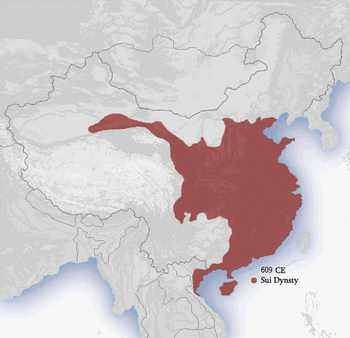Sui dynasty facts for kids
Quick facts for kids
Sui
隋
|
|||||||||||
|---|---|---|---|---|---|---|---|---|---|---|---|
| 581–618 | |||||||||||

Sui dynasty c.609
|
|||||||||||

Administrative division of the Sui dynasty circa 610 AD
|
|||||||||||
| Capital | Daxing (581–605), Luoyang (605–618) | ||||||||||
| Common languages | Middle Chinese | ||||||||||
| Religion | Buddhism, Taoism, Confucianism, Chinese folk religion, Zoroastrianism | ||||||||||
| Government | Monarchy | ||||||||||
| Emperor | |||||||||||
|
• 581–604
|
Emperor Wen | ||||||||||
|
• 604–617
|
Emperor Yang | ||||||||||
| Historical era | Postclassical Era | ||||||||||
|
• Ascension of Yang Jian
|
4 March 581 | ||||||||||
|
• Abolished by Li Yuan
|
23 May 618 | ||||||||||
| Area | |||||||||||
| 589 est. | 3,000,000 km2 (1,200,000 sq mi) | ||||||||||
| Population | |||||||||||
|
• 609
|
est. 46,019,956 | ||||||||||
| Currency | Chinese coin, Chinese cash | ||||||||||
|
|||||||||||
| Today part of | China Vietnam |
||||||||||
| Sui dynasty | |||||||||||||||||||||||||||||
|---|---|---|---|---|---|---|---|---|---|---|---|---|---|---|---|---|---|---|---|---|---|---|---|---|---|---|---|---|---|

"Sui dynasty" in Chinese characters
|
|||||||||||||||||||||||||||||
| Chinese | 隋朝 | ||||||||||||||||||||||||||||
|
|||||||||||||||||||||||||||||
The Sui dynasty (Chinese: 隋朝; pinyin: Suí cháo) was a short-lived imperial dynasty of China of pivotal significance. The Sui unified the Northern and Southern dynasties and reinstalled the rule of ethnic Chinese in the entirety of China proper, along with sinicization of former nomadic ethnic minorities (Five Barbarians) within its territory. It was succeeded by the Tang dynasty, which largely inherited its foundation.
Founded by Emperor Wen of Sui, the Sui dynasty capital was Chang'an (which was renamed Daxing, 581–605) and later Luoyang (605–618). Emperors Wen and Yang undertook various centralized reforms, most notably the equal-field system, intended to reduce economic inequality and improve agricultural productivity; the institution of the Three Departments and Six Ministries system; and the standardization and re-unification of the coinage. They also spread and encouraged Buddhism throughout the empire. By the middle of the dynasty, the newly unified empire entered a golden age of prosperity with vast agricultural surplus that supported rapid population growth.
A lasting legacy of the Sui dynasty was the Grand Canal. With the eastern capital Luoyang at the center of the network, it linked the west-lying capital Chang'an to the economic and agricultural centers of the east towards Hangzhou, and to the northern border near modern Beijing. While the pressing initial motives were for shipment of grains to the capital, and for transporting troops and military logistics, the reliable inland shipment links would facilitate domestic trades, flow of people and cultural exchange for centuries. Along with the extension of the Great Wall, and the construction of the eastern capital city of Luoyang, these mega projects, led by an efficient centralized bureaucracy, would amass millions of conscripted workers from the large population base, at heavy cost of human lives.
After a series of costly and disastrous military campaigns against Goguryeo, one of the Three Kingdoms of Korea, ended in defeat by 614, the dynasty disintegrated under a series of popular revolts culminating in the assassination of Emperor Yang by his ministers in 618. The dynasty, which lasted only thirty-seven years, was undermined by ambitious wars and construction projects, which overstretched its resources. Particularly, under Emperor Yang, heavy taxation and compulsory labor duties would eventually induce widespread revolts and brief civil war following the fall of the dynasty.
The dynasty is often compared to the earlier Qin dynasty for unifying China after prolonged division. Wide-ranging reforms and construction projects were undertaken to consolidate the newly unified state, with long-lasting influences beyond their short dynastic reigns.
Related pages
Images for kids
-
A Sui dynasty pilgrim flask made of stoneware.
-
A Sui dynasty stone statue of the Avalokitesvara Boddhisattva (Guanyin).
-
Chinese swords of the Sui dynasty, about 600, found near Luoyang. The P-shaped furniture of the bottom sword's scabbard is similar to and may have been derived from sword scabbards of the Sarmatians and Sassanians.
-
Model of a Pipa Player, Sui Dynasty
See also
 In Spanish: Dinastía Sui para niños
In Spanish: Dinastía Sui para niños






